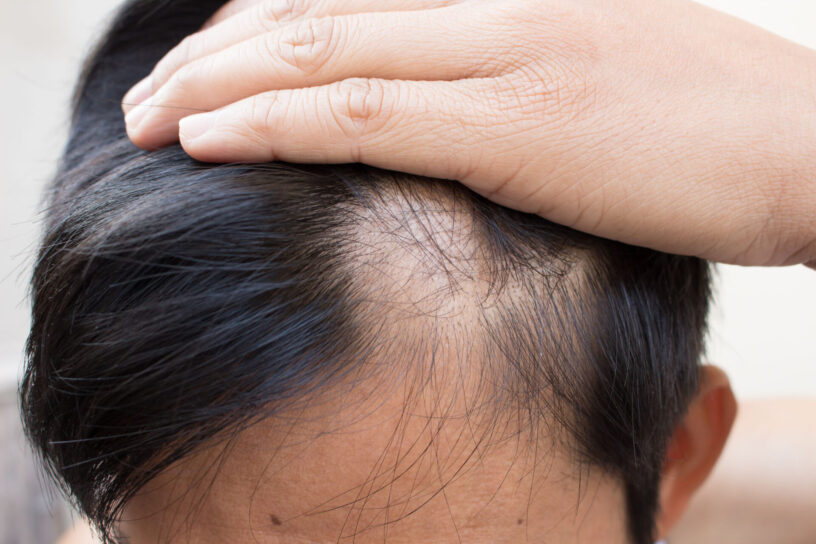Alopecia (Hair Loss)Treatment Market size was valued at USD 8.77 billion in 2023 and is expected to grow at a compound annual growth rate (CAGR) of 9.1% from 2024 to 2030.
The Alopecia (Hair Loss) Treatment Market is expanding rapidly due to rising awareness, increasing incidences of hair loss across all age groups, and advancements in treatment options. Alopecia is a condition that causes hair to fall out, either in patches or completely, and can affect men, women, and children. The market encompasses a wide range of treatments, including medications, surgical procedures, and non-invasive therapies, designed to address various forms of alopecia, such as androgenic alopecia, alopecia areata, traction alopecia, and scarring alopecia.
Key Market Drivers:
- Rising Prevalence of Hair Loss Disorders: Hair loss affects a significant portion of the global population, with conditions like androgenic alopecia being particularly common in both men and women. Increasing stress levels, hormonal imbalances, changing lifestyle habits, and genetic predisposition are contributing to the rising incidence of alopecia.
- Increased Awareness and Acceptance: Social acceptance and openness toward hair loss treatments have grown significantly, especially in men suffering from male pattern baldness and women experiencing thinning hair. People are more aware of the treatment options available, leading to an increased demand for both medical and cosmetic solutions.
- Technological Advancements in Treatment: Innovations in hair restoration technologies, such as Platelet-Rich Plasma (PRP) therapy, low-level laser therapy (LLLT), and advanced hair transplantation techniques, are driving market growth. Non-surgical options such as PRP and laser treatments are becoming increasingly popular for their minimally invasive nature and potential for effective results.
- Growing Demand for Hair Transplantation Procedures: Hair transplantation, particularly follicular unit extraction (FUE) and follicular unit transplantation (FUT), remains one of the most effective treatments for permanent hair restoration. Advances in these procedures, including robotic-assisted transplants and natural-looking results, are increasing their popularity.
- Increased Focus on Personal Grooming: The global trend toward aesthetic enhancement and personal grooming has led to a greater focus on hair loss treatments. Both men and women are investing in products and therapies that can help maintain or restore hair health, driving demand for various treatment options.
- Emerging Topical and Oral Medications: FDA-approved treatments such as minoxidil and finasteride remain key medications for hair loss, but new pharmaceutical innovations, including topical solutions, oral treatments, and hormonal therapies, are expanding the market. Increasing research on Janus kinase (JAK) inhibitors and other novel drug classes for alopecia areata is further advancing medical treatment options.
Market Segmentation:
- By Type of Treatment:
- Topical Treatments: Includes FDA-approved over-the-counter and prescription treatments like minoxidil and herbal hair growth solutions.
- Oral Medications: Includes finasteride, a prescription medication for male pattern baldness, and other oral treatments being developed for alopecia areata and other forms.
- Hair Transplantation: Surgical solutions, including FUE and FUT, remain a major segment of the market, especially for those seeking permanent hair restoration.
- Platelet-Rich Plasma (PRP) Therapy: A minimally invasive option gaining traction for its regenerative properties that can stimulate hair growth.
- Low-Level Laser Therapy (LLLT): An increasingly popular non-surgical option using lasers to stimulate hair growth.
- Other Therapies: Includes stem cell therapy, microneedling, and combination treatments aimed at addressing underlying causes of hair loss.
- By Type of Alopecia:
- Androgenic Alopecia: Also known as male and female pattern baldness, it is the most common type of hair loss driven by genetics and hormonal factors.
- Alopecia Areata: An autoimmune disorder leading to patchy hair loss, which can progress to total scalp or body hair loss.
- Traction Alopecia: Hair loss caused by prolonged tension on the hair, often due to certain hairstyles.
- Cicatricial (Scarring) Alopecia: A rare form of hair loss where hair follicles are destroyed and replaced with scar tissue, often irreversible.
- Other Forms: Includes telogen effluvium, a temporary form of hair loss caused by stress, illness, or hormonal changes.
- By Gender:
- Male: Men make up a large portion of the market, with male pattern baldness being a primary concern.
- Female: Female hair loss treatments are increasingly being marketed, with an emphasis on hormonal factors and scalp health.
- By Distribution Channel:
- Hospitals and Dermatology Clinics: Major points of treatment for more severe or surgical interventions such as transplants and PRP therapy.
- Online Pharmacies and Retail Stores: Increasing sales of over-the-counter treatments like minoxidil and natural supplements through online channels.
- Home Care Settings: Growth in at-home treatments like laser combs, caps, and hair growth products is driving sales through e-commerce.
- By Region:
- North America: The largest market for hair loss treatments due to a high prevalence of androgenic alopecia, well-established healthcare infrastructure, and strong adoption of hair restoration technologies.
- Europe: Holds a significant market share, with countries like Germany, the UK, and France showing strong demand for hair loss treatments. Increasing adoption of cosmetic procedures and aesthetic products is driving growth in the region.
- Asia-Pacific: The fastest-growing region due to rising awareness, disposable incomes, and increasing acceptance of aesthetic treatments. Countries like South Korea and India are becoming key players in the market.
- Rest of the World: Growing demand in the Middle East, Latin America, and Africa as awareness about alopecia treatments increases, and healthcare infrastructure improves.
Challenges in the Alopecia Treatment Market:
- High Cost of Treatments: Advanced treatments like hair transplants and PRP therapy are often expensive, limiting access for a portion of the population, especially in emerging markets.
- Limited Effectiveness of Some Treatments: Many over-the-counter treatments and medications offer limited results, leading to patient dissatisfaction and a search for alternative solutions.
- Side Effects of Medications: Oral medications like finasteride can have side effects such as decreased libido or hormonal changes, which may deter individuals from using them.
- Lack of Insurance Coverage: In many regions, hair loss treatments, particularly for aesthetic purposes, are not covered by insurance, posing financial barriers to treatment.
- Social Stigma: Despite increased openness around hair loss, there can still be social stigma associated with hair loss, particularly for women, which may delay seeking treatment.
Future Outlook:
The alopecia treatment market is expected to continue growing due to advances in medical and aesthetic treatments. The trend toward minimally invasive therapies, personalized treatments based on genetic profiling, and increased consumer focus on wellness and appearance are likely to boost demand. New drug developments, especially for alopecia areata and other less common forms, hold promise for addressing unmet needs in the market.
Additionally, technological advancements in hair transplantation, the growing acceptance of cosmetic procedures, and increasing awareness of available treatments through online channels will contribute to the market’s expansion. However, reducing costs and improving accessibility to effective treatments will be key in ensuring broader market growth globally.
Click Here, To Get Free Sample Report https://stringentdatalytics.com/sample-request/alopecia-(hair-loss)treatment-market/14678/
Market Segmentations:
Global Alopecia (Hair Loss)Treatment Market: By Company
Cipla
Dr. Reddy’s Laboratories
Regaine
Merck
Ranbaxy Laboratories
Vitabiotics
Nanogen
Alpecin
Johnson and Johnson
Global Alopecia (Hair Loss)Treatment Market: By Type
Vitamins and Supplements
Shampoos and Conditioners
Others
Global Alopecia (Hair Loss)Treatment Market: By Application
Men
Women
Children
Global Alopecia (Hair Loss)Treatment Market: Regional Analysis
The regional analysis of the global Alopecia (Hair Loss)Treatment market provides insights into the market’s performance across different regions of the world. The analysis is based on recent and future trends and includes market forecast for the prediction period. The countries covered in the regional analysis of the Alopecia (Hair Loss)Treatment market report are as follows:
North America: The North America region includes the U.S., Canada, and Mexico. The U.S. is the largest market for Cold-chain Pharma in this region, followed by Canada and Mexico. The market growth in this region is primarily driven by the presence of key market players and the increasing demand for the product.
Europe: The Europe region includes Germany, France, U.K., Russia, Italy, Spain, Turkey, Netherlands, Switzerland, Belgium, and Rest of Europe. Germany is the largest market for Cold-chain Pharma in this region, followed by the U.K. and France. The market growth in this region is driven by the increasing demand for the product in the automotive and aerospace sectors.
Asia-Pacific: The Asia-Pacific region includes Singapore, Malaysia, Australia, Thailand, Indonesia, Philippines, China, Japan, India, South Korea, and Rest of Asia-Pacific. China is the largest market for Cold-chain Pharma in this region, followed by Japan and India. The market growth in this region is driven by the increasing adoption of the product in various end-use industries, such as automotive, aerospace, and construction.
Middle East and Africa: The Middle East and Africa region includes Saudi Arabia, U.A.E, South Africa, Egypt, Israel, and Rest of Middle East and Africa. The market growth in this region is driven by the increasing demand for the product in the aerospace and defense sectors.
South America: The South America region includes Argentina, Brazil, and Rest of South America. Brazil is the largest market for Cold-chain Pharma in this region, followed by Argentina. The market growth in this region is primarily driven by the increasing demand for the product in the automotive sector.
Click Here, To Buy Premium Report https://stringentdatalytics.com/purchase/alopecia-(hair-loss)treatment-market/14678/?license=single
Key Points:
- Define, describe and forecast The Global Market by type, application, end user and region.
- Provide enterprise external environment analysis and PEST analysis.
- Provide strategies for company to deal with the impact of COVID-19.
- Provide market dynamic analysis, including market driving factors, market development constraints.
- Provide market entry strategy analysis for new players or players who are ready to enter the market, including market segment definition, client analysis, distribution model, product messaging and positioning, and price strategy analysis.
- Keep up with international market trends and provide analysis of the impact of the COVID-19 epidemic on major regions of the world.
- Analyze the market opportunities of stakeholders and provide market leaders with details of the competitive landscape.
About Stringent Datalytics
Stringent Datalytics offers both custom and syndicated market research reports. Custom market research reports are tailored to a specific client’s needs and requirements. These reports provide unique insights into a particular industry or market segment and can help businesses make informed decisions about their strategies and operations.
Syndicated market research reports, on the other hand, are pre-existing reports that are available for purchase by multiple clients. These reports are often produced on a regular basis, such as annually or quarterly, and cover a broad range of industries and market segments. Syndicated reports provide clients with insights into industry trends, market sizes, and competitive landscapes. By offering both custom and syndicated reports, Stringent Datalytics can provide clients with a range of market research solutions that can be customized to their specific needs.
Contact Us
Stringent Datalytics
Contact No- +1 346 666 6655
Email Id- sales@stringentdatalytics.com




Leave a Reply